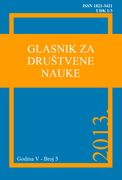Šta smo dobili a šta izgubili primenom reţima targetiranja inflacije u Srbiji?
What we gained and what we lost by applying regime of inflation targeting in Serbia?
Author(s): Mehmed MurićSubject(s): Economy
Published by: АЛФА БК УНИВЕРЗИТЕТ
Keywords: Inflation targeting; economic growth; inflation
Summary/Abstract: Monetary policy is a very important segment of an allencompassing economic policy. Monetary policies can prevent money becoming the most important source of economic disturbances. In spite of the theoretical dilemmas of opposing schools of thought, monetary policy is a powerful medium for monetary authorities in directing real economic processes. Serbia adopted the regime of inflation targeting in September 2006, as its commitment to monetary policy management. The assessment of the fulfillment of conditions necessary for implementing the inflation targeting regime states that Serbia has made good progress. However, two elements can be distinguished as potential limiting factors of the range of new monetary policy. The first factor represents the undeveloped financial markets either regarding the number of financial instruments available to trade or the scope of transactions making fine tuning of monetary policy in Serbia impossible to expect. The second factor is the internalization of the banking sector. Over 70% of the banking system in Serbia is owned by foreign banking groups. Considering the possibility of credit options abroad and recapitalizations by their centrals, some limitations can appear in the range of channels of interest rates by weakening the main instrument of monetary policy. According to our opinion two other motives should be considered for introducing channels of interest rates as nominal anchors of monetary policy in Serbia. The experience of countries that adopted the regime of inflation targeting states that the implementation of this concept of monetary policy stabilized inflation and its expectations, which was all of great importance because of increased investment activities of large foreign investors. Monetary authorities in Serbia desired to enable a transparent insight into monetary movements in this way, but also to create a climate of stable inflation expectations and stable inflation, to ensure the best condition for continuing and increasing investment activities in Serbia. Another argument contributing to the motives for change of nominal anchors is the expense of national currency in the process of disinflation. This paper tries to answer the question of what Serbia gained and lost by applying the regime of inflation targeting as the monetary policy framework. The results show some positive changes and stabilization of certain macroeconomic variables and, on the other hand, a lower average rate of economic growth.
Journal: Glasnik za društvene nauke
- Issue Year: 2013
- Issue No: 5
- Page Range: 189-228
- Page Count: 20
- Language: Serbian

